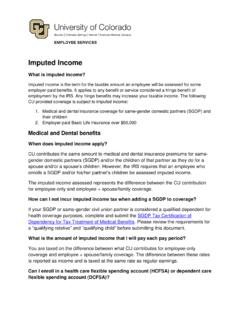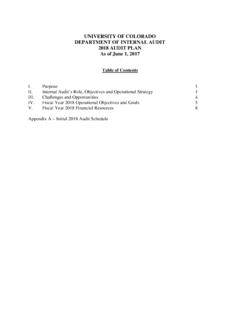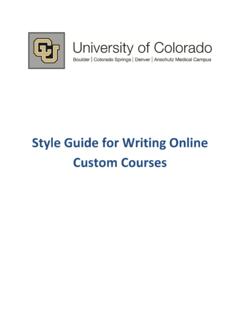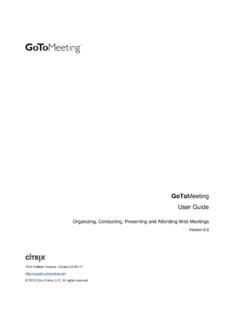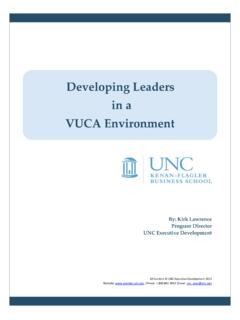Transcription of Student Barriers to Online Learning: A factor analytic study
1 Distance EducationVol. 26, No. 1, May 2005, pp. 29 48 ISSN 0158-7919 (print); 1475-0198 ( Online )/05/010029 20 2005 Open and Distance learning Association of Australia, : Barriers to Online learning : A factor analytic studyLin Y. Muilenburga* and Zane L. BergebaUniversity of South Alabama, USA; bUniversity of Maryland, USAT aylor and Francis Education0158-7919 (print)/1475-0198 ( Online )Original Article2005 Open and Distance learning Association of Australia, 2005 LinMuilenburgUniversity of South Alabama2460 Wildflower LaneHuntingtonMD article reports on a large-scale (n = 1,056), exploratory factor analysis study that determinedthe underlying constructs that comprise Student Barriers to Online learning .
2 The eight factorsfound were (a) administrative issues, (b) social interaction, (c) academic skills, (d) technical skills,(e) learner motivation, (f) time and support for studies, (g) cost and access to the Internet, and (h)technical problems. Independent variables that significantly affected Student ratings of thesebarrier factors included: gender, age, ethnicity, type of learning institution, self-rating of onlinelearning skills, effectiveness of learning Online , Online learning enjoyment, prejudicial treatment intraditional classes, and the number of Online courses the popularity of the Internet grows, so does the potential for Online learning .
3 Agreat deal of evidence exists showing that no significant differences should beexpected regarding the effectiveness of well-designed Online learning compared withwell-designed in-person learning (Clark, 1983; Russell, 1999). Despite this, signifi-cant differences still exist in the way students perceive their Online experiencesduring learning . To the extent that these students perceptions are negative regard-ing their past, present, or future Online learning experiences, the students percep-tions may contribute to such outcomes as higher dropout rates (Carr, 2000), lowmotivation of students to learn (Maltby & Whittle, 2000), and lower Student satis-faction with the learning experience (Kenny, 2003).
4 Still, these outcomes are nottrue for all students , in all situations, and at all times. What causes individual differ-ences in outcomes for Online learners?Research on individual differences among students is conducted to increase ourability to design instruction, to improve how we instruct, and to advise students . In*Corresponding author. 2460 Wildflower Lane, Huntingtown, MD 20639, USA. Y. Muilenburg and Z. L. Bergepart, we want to better understand which students will face Barriers when attemptingto learn Online , what those Barriers are, and ultimately how we can help individualsin their learning by understanding and ameliorating their particular survey research reported in this article sought to represent the perceptions ofstudents who differed on 11 independent variables: (a) gender; (b) age; (c) self-reported ethnicity.
5 (d) type of learning institution they attended ( , communitycollege, undergraduate, graduate, business/corporate/non-profit, and government/military); (e) ability and confidence with Online learning technology (from notcurrently using these technologies to being comfortable and confident with onlinelearning technologies ); (f) learning effectiveness in the Online environment (from cannot learn as well Online , through no difference between Online and traditionalclassroom, to learn better Online ); (g) learning enjoyment in the Online classroom(from enjoy Online learning significantly less, to enjoy Online learning signifi-cantly more than the traditional classroom ); (h) the number of Online coursescompleted; (i) the number of Online courses dropped; (j) the likelihood of taking afuture Online course; and (k) whether or not students experienced prejudicial treat-ment in the traditional classroom due to cultural background, disability, or otherpersonal characteristic.
6 More than 1,000 survey respondents rated the severity of 47separate Student Barriers to distance education on a 1 5 Likert scale (from nobarrier to a very strong barrier, respectively).Literature ReviewStudies have documented both favorable and unfavorable students perceptions indistance education. The authors reviewed the literature specifically on students perceived Barriers to Online learning and more generally on students perceivedbarriers to learning . The goal was to seek out Barriers , issues, and success factorsfrom the students perspectives that may affect the learning outcomes ( , learningeffectiveness, learner attitudes, and motivation).
7 We also searched for indications ofwhat background characteristics and demographics of the learner might affect theoutcomes of their Online learning . Previous studies have found significant differencesin learning , attitudes, motivation, or experiences based on: (1)gender ( , Chen, 1986; Teo & Lim, 2000; Young, 2000);(2)age ( , Rekkedal, 1983);(3)ethnicity ( , Owens, 1998; Branden & Lambert, 1999; Chen, 1999);(4) ability and confidence with Online learning technology (from not currentlyusing these technologies to being comfortable and confident with onlinelearning technologies ).
8 In other words, students experiences with learning tech-nologies ( , Koohang, 1989; Hara, 1998; Hara & Kling, 1999);(5) the type of learning institution they attend (community college, undergraduate,graduate, business/corporate/non-profit, and government/military) which maybe compared outright, or which may also speak to their prior educational level( , Rekkedal, 1983; Sheets, 1992; Mungania, 2003); andStudent Barriers to Online Learning31(6) learning effectiveness in the Online environment (from cannot learn as wellonline, through no difference between Online and traditional classroom, to learn better Online ), or self-efficacy their perceptions that one can be asuccessful Student Online (Mungania, 2003).
9 To these we added several variables we wanted to explore: (7) learning enjoyment in the Online classroom ( enjoy Online learning significantlyless, to enjoy Online learning significantly more than the traditional class-room );(8)number of Online courses completed;(9)number of Online courses dropped;(10)likelihood of taking a future Online course; and(11)whether students experienced prejudicial treatment in the traditional classroom dueto cultural background, disability or other personal rounds of this survey were conducted. The first is identified here as the pilotstudy, and the second round as the main study .
10 Pilot StudyThe initial survey items were drawn from a review of literature, from previous stud-ies on Barriers conducted by Muilenburg and Berge (2001), and from content analy-ses of selected case studies (Berge & Mrozowski, 2001).The literature was reviewed for an initial organizing framework. Garland (1993)studied Student perceptions of the situational, institutional, dispositional, and episte-mological Barriers to persistence. Later, Schilke (2001), updating Garland s modelof Barriers to persistence in distance education, added a technical factor .

